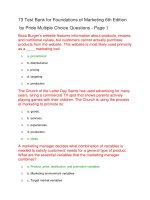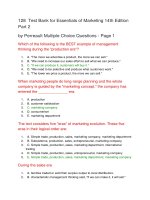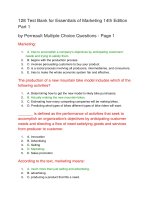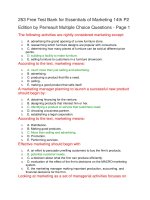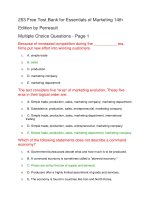55 freetest bank for essentials of marketing research 5th edition
Bạn đang xem bản rút gọn của tài liệu. Xem và tải ngay bản đầy đủ của tài liệu tại đây (108.7 KB, 19 trang )
35 FreeTest Bank for Essentials of Marketing Research
5th Edition by Zikmund Mutiple Choice Questions
22 FreeTest Bank for Essentials of Marketing Research 5th
Edition by Zikmund Free Text Questions
20 FreeTest Bank for Essentials of Marketing Research 5th
Edition by Zikmund True – False Questions
Which of the following is the first step in developing a marketing
strategy?
1.
a.analyzing firm performance
2.
b.identifying and evaluating market opportunities
3.
c.selecting target markets
4.
d.planning and implementing a marketing mix that will provide value to
customers and meet organizational objectives
According to the concept of cross-functional activities, which of the
following can affect the organization's marketing efforts?
1.
a.the research & development department
2.
b.the accounting department
3.
c.the production department
4.
d.all of these choices
Which aspect of the marketing mix is represented by the value that
a consumer places on a good when this consumer purchases that
good?
1.
a.product
2.
b.place
3.
c.price
4.
d.promotion
Pamela is testing the hypothesis that states consumers will think a
laundry detergent packaged in a pastel-colored container will
perceive the detergent to be more mild than one packaged in a
neon-orange container. Pamela is conducting _____.
1.
a.qualitative research
2.
b.essential research
3.
c.scientific deduction
4.
d.marketing research
All of the following are important aspects of the marketing research
process EXCEPT:
1.
a.gathering information
2.
b.idea and theory development
3.
c.analyzing data
4.
d.making results publicly available
When Pottery Barn conducted research to determine which
products it should offer to customers over the Internet, this was an
example of which type of research?
1.
a.distribution research
2.
b.promotion research
3.
c.pricing research
4.
d.product research
When Cheetos snack food conducted research in China to
determine which flavors consumers would find appealing, this was
an example of which type of research?
1.
a.pricing research
2.
b.promotion research
3.
c.product research
4.
d.distribution research
When an organization is attempting to decide whether to use a
company such as UPS or FedEx to deliver its products or to
establish its own means to deliver the product to its customers, this
is an example of which type of research?
1.
a.promotion research
2.
b.pricing research
3.
c.distribution research
4.
d.product research
A network of interdependent institutions that perform the logistics
necessary for consumption to occur is called a _____.
1.
a.marketing channel
2.
b.distribution network
3.
c.supply channel
4.
d.distribution linkage
A firm focusing more on how to provide value to customers than on
the physical product or production process is embracing which
orientation?
1.
a.marketing orientation
2.
b.quality orientation
3.
c.external orientation
4.
d.value orientation
All of the following are a type of product research EXCEPT _____.
1.
a.concept testing
2.
b.product testing
3.
c.brand-name evaluation
4.
d.pricing analysis
Research that attempts to determine which critical attributes of the
product consumers use to perceive the value of the product is an
example of which type of research?
1.
a.product research
2.
b.distribution research
3.
c.promotion research
4.
d.pricing research
When Procter & Gamble attempts to determine the effectiveness of
mailing free samples of a new type of shampoo to residents in
specific zip codes on unit sales performance, it is engaged in which
type of research?
1.
a.product research
2.
b.distribution research
3.
c.promotion research
4.
d.pricing research
_____ is conducted to address a specific marketing decision for a
specific firm or organization.
1.
a.Basic marketing research
2.
b.Qualitative marketing research
3.
c.Quantitative marketing research
4.
d.Applied marketing research
Which of the following are the two types of marketing research
based on the specificity of its purpose?
1.
a.basic and applied
2.
b.scientific and non-scientific
3.
c.cross-sectional and qualitative
4.
d.quantitative and secondary
Asking consumers what they think about possible brand names for
a new product is an example of which type of research?
1.
a.product research
2.
b.promotion research
3.
c.product testing
4.
d.concept testing
When a marketing manager is trying to decide whether a new
product launch decision should be postponed until some additional
marketing research can be conducted, which of the following
questions should this manager ask himself or herself?
1.
a.Is the proposed research expenditure the best use of the available funds?
2.
b.Will the information gained by marketing research improve the quality of the
marketing decision enough to warrant the expenditure?
3.
c.Will the payoff from the research be worth the dollar expenditures for
research?
4.
d.all of these choices
Which of the following refers to the way researchers go about using
knowledge and evidence to reach objective conclusions about the
real world?
1.
a.qualitative method
2.
b.quantitative method
3.
c.scientific method
4.
d.primary method
When McDonald's studies traffic patterns and population density
patterns in order to select sites for future restaurants, this is an
example of which type of research?
1.
a.pricing research
2.
b.distribution research
3.
c.promotion research
4.
d.product research
Which type of research tries to verify a theory or to learn more
about a marketing concept and is not intended to solve a particular
marketing problem?
1.
a.performance-monitoring research
2.
b.basic research
3.
c.total quality management
4.
d.the scientific method
When Wal-Mart is attempting to decide where to locate its regional
warehouses in order to minimize travel time from its warehouses to
its stores, this is an example of which type of research?
1.
a.product research
2.
b.pricing research
3.
c.distribution research
4.
d.promotion research
When the typical consumer in zip code 63119 is a senior citizen
with several children over the age of 25, has a college degree, and
is retired, this is an example of what type of information?
1.
a.TQM
2.
b.performance-monitoring
3.
c.geo-demographic
4.
d.the marketing concept
_____ is the communication function of the firm responsible for
informing and persuading buyers.
1.
a.Marketing
2.
b.Research
3.
c.Distribution
4.
d.Promotion
A marketing professor is examining the relationship between age
and shoplifting behavior. The research is not being conducted for
any specific retailer, but rather it is intended to better understand
and predict this behavior. This professor is conducting which type of
marketing research?
1.
a.basic marketing research
2.
b.formal marketing research
3.
c.applied marketing research
4.
d.abstract marketing research
Consumer research conducted in the United States indicates that
many consumers consider the country of origin when purchasing
products, and consumers tend to prefer products that are made in
the U.S.A. To determine if consumers in other countries are partial
to their own country’s products, what must be done before the
empirical findings from the research conducted among U.S.
consumers also exist and behave similarly in another culture?
1.
a.reliability assessment
2.
b.cultural cross-validation
3.
c.benefit/cost analysis
4.
d.cultural-monitoring research
Asking target market members to compare the performance of a
prototype of a possible new product to the performance of a
competitor's product is an example of which type of research?
1.
a.distribution research
2.
b.copytesting
3.
c.promotion research
4.
d.product testing
Campbell’s Soup is considering launching a new gumbo product
and is testing different recipes with consumers before full
commercialization. What type of research is Campbell’s using to
determine which soup consumers will like the best?
1.
a.secondary marketing research
2.
b.basic marketing research
3.
c.applied marketing research
4.
d.test marketing research
Ensuring that all promotional efforts, such as advertising, public
relations, personal selling, and so forth, are coordinated to
communicate a consistent image is the basic tenet underlying
_____.
1.
a.synergistic marketing communications
2.
b.integrated marketing mix
3.
c.integrated marketing communications
4.
d.promotion research
Marketers of snack foods who consider the nutritional value that
parents desire as well as the fun and experience that children want
are demonstrating a(n) _____.
1.
a.emphasis on short-term profits
2.
b.cross-functional perspective
3.
c.customer orientation
4.
d.product orientation
When a marketing manager decides not to do research because a
decision needs to be made before the results of the study can be
analyzed, this is an example of which aspect in the determination of
the need for marketing research?
1.
a.nature of the decision
2.
b.time constraints
3.
c.availability of the data
4.
d.cost considerations
When Target stores monitors the sales activities of its retail stores
in order to detect any indication of dollar sales changes, this is an
example of which type of research?
1.
a.relationship marketing research
2.
b.total quality management research
3.
c.basic research
4.
d.performance-monitoring research
_____ is the application of the scientific method in searching for the
truth about marketing phenomena.
1.
a.Marketing
2.
b.Business
3.
c.Marketing Research
4.
d.Science
Which of the following is an important aspect of the marketing
concept?
1.
a.a cross-functional perspective for the coordination of the organization's
activities
2.
b.an emphasis on long-term profitability instead of dollar sales volume
3.
c.a consumer orientation
4.
d.all of these choices
What type of information describes the demographic profile of
consumers in a particular geographic region?
1.
a.geo-demographics
2.
b.psychographics
3.
c.economic indicators
4.
d.place-based demographics
When Nike discovered an 80 percent recognition of its logo with
consumers who typically spend at least $100 on athletic shoes, this
was an example of which type of research?
1.
a.distribution research
2.
b.promotion research
3.
c.pricing research
4.
d.product research
20 FreeTest Bank for Essentials of Marketing Research
5th Edition by Zikmund True - False Questions
The term “research” means “to search again.”
1.
True
2.
False
Concept testing is a form of product research.
1.
True
2.
False
Marketing research is restricted to the promotion aspect of the
marketing mix.
1.
True
2.
False
Developing and implementing a marketing strategy involves six
stages.
1.
True
2.
False
The most common forms of performance-monitoring research are
sales performance and profit analyses.
1.
True
2.
False
The scientific method used by researchers is essentially the same
process in marketing as it is in “hard” sciences, such as biology or
physics.
1.
True
2.
False
A stakeholder orientation recognizes that multiple parties are
affected by firm decisions.
1.
True
2.
False
Distribution research focuses on the network of interdependent
institutions that perform the logistics necessary for consumption to
occur.
1.
True
2.
False
Communication technologies have impacted marketing research
greatly.
1.
True
2.
False
The procedures and techniques used by applied researchers and
basic researchers differ substantially.
1.
True
2.
False
Marketing research is relevant to and used by non-profit
organizations.
1.
True
2.
False
Marketing research plays a more prominent role in product-oriented
companies than in customer-oriented companies.
1.
True
2.
False
When ideas can be stated in researchable terms, we reach the
hypothesis stage of the scientific method.
1.
True
2.
False
A marketing researcher needs to be subjective in order to provide
accurate information.
1.
True
2.
False
When a marketing researcher describes the age, gender, income,
and education of consumers in a particular city, this is known as
geo-demographic information.
1.
True
2.
False
Marketing research is basically about conducting surveys.
1.
True
2.
False
Keeping customers is less important that getting customers.
1.
True
2.
False
Conducting research to determine why consumers visit Starbucks is
an example of basic marketing research.
1.
True
2.
False
Marketing research should be conducted regardless of how long it
will take to perform.
1.
True
2.
False
A customer orientation means that all firm decisions are made with
a conscious awareness of their effect on the bottom line (that is,
profits).
1.
True
2.
False
22 FreeTest Bank for Essentials of Marketing Research
5th Edition by Zikmund Free Text Questions
The _____ orientation recognizes that multiple parties are affected
by firm decisions.
Answer Given
stakeholder
The term _____ is sometimes used to refer to a channel of
distribution.
Answer Given
supply chain
One of the goals of marketing is to establish a long-term
relationship with customers so that they continue to purchase the
organization's products in the future. This is known as ______.
Answer Given
relationship marketing
Explain the differences among a product-oriented firm, a
production-oriented firm, and a marketing-oriented firm and the role
marketing research plays in each.
Answer Given
A product-oriented firm prioritizes decision making in a way that emphasizes
technical superiority in the product. A production-oriented firm prioritizes efficiency
and effectiveness of the production processes in making decisions. In both of these
orientations, marketing research may take a backseat. In contrast, marketing
research is a primary tool enabling implementation of a marketing orientation. A
marketing-oriented firm must: (1) be customer-oriented, (2) emphasize long-run
profitability rather then short-term profits or sales volume, and (3) adopt a crossfunctional perspective.
The two types of marketing research based on the specificity of its
purpose are called basic and _____ research.
Answer Given
applied
Discuss the factors that influence whether or not marketing
research is needed.
Answer Given
The determination of the need for marketing research centers on: (1)Time
constraints - systematic research takes time, and sometimes the urgency of a
situation precludes the use of research; (2)Availability of data - when managers lack
adequate information, data need to be collected from an appropriate source in a
timely fashion; (3)Nature of the decision - in general, the more strategically or
tactically important the decision, the more likely it is that research will be conducted;
(4)Benefits versus costs - when deciding whether to make a decision without
research or to postpone the decision in order to conduct research requires
examining whether the payoff or rate of return will be worth the investment, whether
the information gained by marketing research will improve the quality of the
marketing decision enough to warrant the expenditure, and whether the proposed
research expenditure is the best us of the available funds.
When a company focuses all of its efforts aimed at consumers
based on its technical superiority in product design and features,
this company is said to be _____ - oriented.
Answer Given
product
Explain why marketing research, like all business activity, continues
to change.
Answer Given
Changes in communication technologies and the trend toward an ever more global
marketplace have played a large role in many of these changes. With respect to
communication technologies, virtually everyone is “connected” today and the speed
with which information can be exchanged has increased tremendously. Changes in
computer technology have also made for easier data collection and data analysis.
Markets today have few, if any, geographic boundaries. Companies that conduct
business in foreign countries must understand the nature of those particular markets
and judge whether they require customized marketing strategies. The
internationalization of research places greater demands on marketing researchers
and heightens the need for research tools that allow us to cross-validate research
results, which means that the empirical findings from one culture also exist and
behave similarly in another culture.
Information describing the demographic profile of consumers in a
particular geographic region is called _____.
Answer Given
geo-demographics
You’ve just been hired as a research assistant in the brand
management unit of a major consumer packaged-goods
manufacturer. Describe two types of product research you may be
involved in conducting.
Answer Given
Product research takes many forms and includes studies designed to evaluate and
develop new products and to learn how to adapt existing product lines, and students
can discuss any two to answer this question. Concept testing exposes potential
customers to a new product idea to judge the acceptance and feasibility of the
concept. Product testing reveals a product prototype’s strengths and weaknesses or
determines whether a finished product performs better than competing brands or
according to expectations. Brand-name evaluation studies investigate whether a
name is appropriate for a product. Finally, package-testing assesses size, color,
shape, ease of use, and other attributes of a package.
Organizations conducting research in order to make a decision
about a real situation faced in the marketplace are conducting
______ research.
Answer Given
applied
Discuss how businesses analyze marketing performance and the
role performance-monitoring research performs in this function.
Answer Given
Performance-monitoring research refers to research that regularly, sometimes
routinely, provides feedback for evaluation and control of marketing activities.
Market-share analysis and sales analysis are the most common forms of
performance monitoring research. Almost every organization compares its current
sales with previous sales and with competitors’ sales. However, analyzing marketing
performance is not limited to the investigation of sales figures. Other marketing
metrics, such as return on investment, are used as well.
The application of the scientific method in searching for truth about
marketing phenomena is known as ______.
Answer Given
marketing research
When empirical evidence from two different cultures suggests that
people in one culture act in ways that are similar to people in a
different culture, we say that this fact _____ the hypothesis that the
two cultures are similar to one another.
Answer Given
cross-validates
A company that applies the marketing concept in its dealings with
its customers is using a _____ orientation.
Answer Given
marketing
Describe basic and applied marketing research and design an
example of each.
Answer Given
Applied marketing research is conducted to address a specific marketing decision for
a specific firm or organization. It is relatively specific, and an example is Wendy’s
fast food restaurant trying to determine if its new veggie burger will be successful.
Basic marketing research is conducted without a specific decision in mind, and it
usually does not address the needs of a specific organization. It attempts to expand
the limits of marketing knowledge in general, and as such is not aimed at solving a
particular pragmatic problem. For example, a marketing researcher might study the
effects of music on consumption in a restaurant setting.
The way researchers go about using knowledge and evidence to
reach objective conclusions about the real world is known as the
______ method.
Answer Given
scientific
_____ research investigates the effectiveness of advertising,
premiums, coupons, sampling, discounts, public relations, and so
forth.
Answer Given
Promotion
Marketing _____ refer to quantitative ways of monitoring and
measuring marketing performance.
Answer Given
metrics
_____ testing exposes potential customers to a new product idea to
judge the acceptance and feasibility of the concept.
Answer Given
Concept
Research that attempts to verify a theory but which is not intended
to solve any specific business problem is known as ______
research.
Answer Given
basic
Discuss how marketing researchers apply the scientific method
when conducting marketing research.
Answer Given
The scientific method is the way researchers go about using knowledge and
evidence to reach objective conclusions about the real world. In the scientific
method, there are multiple routes to developing ideas, such as through prior
knowledge or observation. When the ideas can be stated in researchable terms, we
reach the hypothesis stage. The next step involves testing the hypothesis against
empirical evidence (facts from observation or experimentation). The results either
support a hypothesis or do not support a hypothesis. From these results, new
knowledge is acquired.

